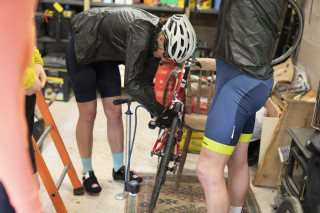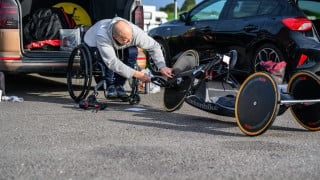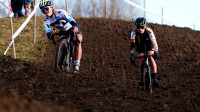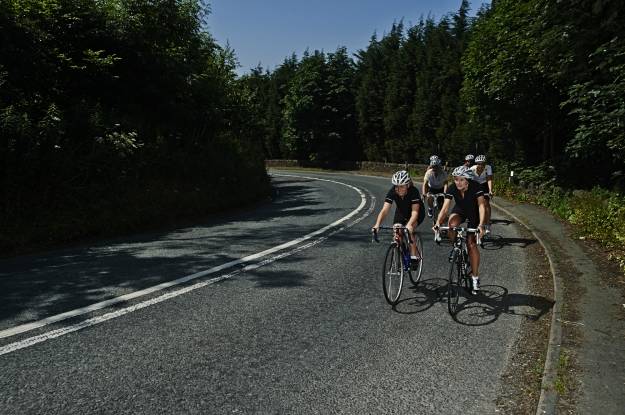Tyre pressure might not be the most thrilling aspect of cycling, but it is one of the most crucial factors affecting performance, comfort, and safety on the bike.
Whether you are a road racer chasing marginal gains, a BMX rider seeking maximum grip, or a para-cyclist fine-tuning pressure for stability, getting it right can transform your ride. Explore the different tyre types, how different disciplines require specific tyre pressures, the science behind PSI, and how to find the perfect balance for your bike and riding style.
Why tyre pressure matters
Tyre pressure affects five key elements of your ride:
-
Rolling resistance – Lower pressure increases contact with the ground, improving grip, but too low can create drag and slow you down. The key is finding a balance that allows for efficiency without sacrificing control.
-
Grip and reaction – Essential for cornering, braking, and wet conditions.
-
Comfort – Higher PSI can feel harsh on rough terrain, while lower PSI absorbs vibrations.
-
Puncture resistance – Overinflation makes tyres more prone to sharp impacts, while underinflation increases pinch flats.
-
Speed and efficiency – The key is to find the balance between rolling resistance and grip.
Understanding different tyre types
Before adjusting anything, it's essential to understand the different types of tyres and how they impact performance, durability, and maintenance.
Inner tube tyres
Tyres with inner tubes are common across multiple disciplines, which can be made from a variety of materials, including butyl, latex, or TPU (thermoplastic polyurethane).
When fitting an inner tube, it’s crucial to ensure that the rim tape is correctly placed. If the tape does not fully cover the holes in the rim, the tube may push through and puncture, leaving you back where you started. Regularly inspecting rim tape for wear and ensuring it is properly seated can help prevent flats.
Tubular tyres
Tubular tyres are glued directly to a tubular-specific rim. These are favoured in high-performance racing due to their ability to be run at higher pressures and their reduced weight. However, they require careful fitting:
-
The tyre and rim must be securely glued together.
-
Typically, two thin layers of glue are applied to the tyre, while the rim receives up to 3-5 layers depending on whether it’s new or a replacement application.
-
Rushing this process can lead to catastrophic failures, particularly at high speeds, increasing the risk of crashes.
-
Regular maintenance includes checking for cuts, peeling tread, and signs of aging or cracking.
Tubeless tyres
Tubeless systems rely on a tight-fitting tyre, sealed rim tape, and a dedicated valve, eliminating the need for an inner tube. This setup provides benefits such as:
-
Lower rolling resistance and better puncture resistance, as sealant can automatically fill small punctures.
-
Regular maintenance is required, as sealant can evaporate in hot conditions and solidify, necessitating cleaning and refilling.
-
Valve cores should be checked for blockages caused by dried sealant.
-
Riders can also install tyre inserts, which improve responsiveness, enhance stability, and provide additional pinch-flat resistance.

How to check your tyre pressure
Before adjusting anything, it’s important to check your tyres properly. Many rely on a quick prod on the top of the tyre, but this can be unreliable. Instead, try:
-
Most accurate: Use a track pump with a pressure gauge to get a good PSI reading before every ride. However, for a more accurate reading consider a digital gauge.
-
For both inner tubes and tubeless tyres: Squeeze from the sides to check for low pressure - appropriate to your bike and ride.
-
Using body weight: Straddle the wheel, lock your arm out, and use your body weight to press down on the top of the tyre. This approach provides a more reliable reading, as it doesn’t depend on hand strength.
Finding the right PSI for your bike
Different cycling disciplines require different tyre pressures based on tyre width, terrain, rider weight, and riding demands.
Road cycling (80-110 PSI)
-
Race bikes: 90-110 PSI for a balance of speed and grip.
-
Endurance bikes: 80-100 PSI for comfort on long rides.
-
Para-cycling (handcycles, trikes): Like road bikes, pressure can be fine-tuned for stability and comfort, depending on the rider’s setup.
Track cycling (120-200 PSI)
-
Sprint events: 160-200 PSI for maximum efficiency on smooth boards.
-
Endurance events: 120-160 PSI for better control in bunch racing.
-
Para-track cycling (tandems, trikes): PSI varies depending on weight distribution and required grip for banking.
Cyclo-cross (CX) (15-40 PSI)
-
Mud-heavy races: 15-30 PSI for extra grip, though some riders may go even lower depending on conditions.
-
Hard-packed courses: 30-40 PSI for faster rolling.
-
Para-cyclists on adapted CX bikes: Often require lower PSI for increased control on rough terrain.
Mountain biking (MTB) (18-30 PSI)
-
Cross-country (XC): 22-30 PSI to balance grip and rolling speed.
-
Enduro/Downhill: 18-25 PSI for maximum traction and impact absorption.
-
MTB for para-cyclists (handcycles, adaptive bikes): Lower PSI helps improve suspension and stability.
Cycle Speedway (50-80 PSI)
-
Dirt/shale track conditions: 50-70 PSI for grip in loose conditions.
-
Firmer surfaces: 70-80 PSI for quicker acceleration and speed.
BMX (40-100 PSI)
-
Race BMX: 80-100 PSI for speed and minimal rolling resistance.
-
Freestyle BMX: 40-70 PSI for better impact absorption and control.
Gravel and adventure riding (30-60 PSI)
-
Fast rolling gravel: 50-60 PSI for speed.
-
Rough terrain: 30-40 PSI for comfort and grip.
Commuting and leisure (50-80 PSI)
-
Hybrid bikes: 50-70 PSI for a mix of comfort and efficiency.
-
City bikes: 60-80 PSI for urban riding durability.
-
Para-cycling commuters: Tyre pressure should prioritise comfort, especially for wheelchair-accessible bike setups.

Factors affecting tyre pressure
Beyond discipline, PSI should be adjusted based on:
-
Rider weight – Heavier riders need higher PSI, while lighter riders can go lower.
-
Tyre width – Wider tyres allow for lower PSI while maintaining speed and grip.
-
Terrain – Rough roads and trails require lower pressures for better shock absorption.
-
Weather – Wet conditions often require a slight PSI reduction to improve traction.
How to check and maintain your tyre pressure
-
Use a pump with a pressure gauge – Don’t guess; check PSI before every ride.
-
Experiment with PSI – Adjust slightly up or down based on conditions.
-
Check for slow leaks – Even the best tyres lose air over time.
Tyre pressure is one of the simplest yet most effective ways to improve your ride. Whether you’re a track sprinter at 200 PSI, a CX racer at 25 PSI, or a para-cyclist fine-tuning a handcycle setup, the right pressure can enhance performance, comfort, and safety.
Take a few minutes to dial in your PSI, and you’ll feel the difference on every ride.
















